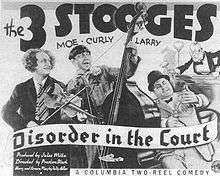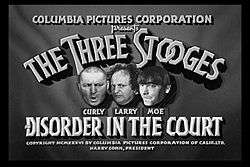Disorder in the Court
| Disorder in the Court | |
|---|---|
 | |
| Directed by | Preston Black |
| Produced by | Jules White |
| Written by | Felix Adler |
| Starring |
Moe Howard Larry Fine Curly Howard Bud Jamison Harry Semels Suzanne Kaaren James C. Morton Edward LeSaint Solomon Horwitz Al Thompson Eddie Laughton |
| Cinematography | Benjamin H. Kline |
| Edited by | William A. Lyon |
| Distributed by | Columbia Pictures |
Release date |
|
Running time | 16:37 |
| Country | United States |
| Language | English |
Disorder in the Court is the 15th short film released by Columbia Pictures in 1936 starring American slapstick comedy team The Three Stooges (Moe Howard, Larry Fine and Curly Howard). The comedians released 190 short films for the studio between 1934 and 1959.
Plot
The Stooges are key witnesses at a murder trial. Their friend and colleague, Gail Tempest (Suzanne Kaaren), is a dancer at the Black Bottom cafe where the Stooges are musicians. She is accused of killing Kirk Robin (a play on "Who Killed Cock Robin?").

When the Stooges are called to the witness stand, they are nowhere to be found. The defense attorney (Bud Jamison) goes out into the hall only to find the Stooges playing jacks and tic-tac-toe simultaneously on the floor. After considerable mutual frustration, the court finally swears in Curly, who begins to describe the events that took place on the night of the murder. He offers to show the court exactly what happened. The Stooges and Gail are part of a musical act; and the Stooges break into their musical routine to prove this, with Larry on violin, Moe harmonica, and Curly on both spoons and upright bass. Gail Tempest shrugs off her coat and reveals her dancer costume, to the great surprise of the jury.
The act is interrupted when Larry unknowingly mistakes a man's toupée for a tarantula and Moe subsequently takes the guard's gun and starts shooting the toupée, causing pandemonium in the court. After the song ends, Curly slaps Moe on the back and makes him swallow his harmonica, briefly turning him into a musical instrument that Larry and Curly comically play a song with before Curly helps Moe spit the harmonica back out. Curly is then seen chewing gum and sternly told by the judge to get rid of it. He throws it away, but it accidentally lands on Moe's face. Larry then takes a napkin and removes the gum, twisting Moe's nose in pain. Larry then stomps on it and bellows out in a loud exaggerated Tarzan yell. Moe slaps him and tells him to get out. After everything is brought under control, Moe and Curly re-enact the actual murder (with Curly on the receiving end). Moe then looks at the parrot, who was at the murder scene, and sees a note tied to the parrot's foot. He opens the parrot cage, and the parrot flies out after it scratches Moe's finger. The Stooges eventually capture the bird by shooting water at it through a fire hose. Moe then reads the letter out loud and reveals that it is a confession from the real murderer, Buck Wing, which finally proves Gail's innocence. The note also said that Buck Wing will disappear. Just when they are going to get their picture taken at the front page, the water hose (which had to be tied in a knot to stop the flow of water when the bailiff broke the fixture trying to turn it off) explodes, wetting everyone in attendance.
Production notes
Disorder in the Court was filmed over six days on April 1–6, 1936.[1] The film title is a play on the stereotypical judge's cry, "Order in the court!"[2]
A colorized version of this film was released in 2006 as part of the DVD collection "Stooges on the Run."
Sol Horwitz, the father of Moe, Curly, and Shemp Howard, makes an uncredited appearance as a member of the public audience.[2]

This is the first Stooge short in which Curly is spelled "C-U-R-L-Y" in the opening titles instead of the previous "C-U-R-L-E-Y." The title card also has the Stooges inverted reading from left to right, Curly-Larry-Moe, as opposed to Moe-Larry-Curly in previous shorts, effectively giving Curly "top billing." This change in the title card coincides with the refined and more familiar Columbia Pictures image of a torch-bearing woman, with a shimmering light instead of the primitive animation of light rays in the previous version. In addition, the "Columbia" theme now uses a more upbeat theme, featuring a brass introduction.[2]
NOTE: The above commentary is not exactly correct. As the Horowitz family was Jewish, as was most of the production crew, the Billing is still Moe-Larry-Curly when read from RIGHT to LEFT, which is how Hebrew is also read. This is hardly a coincidence, but a planned subtle change that most American gentile moviegoers would not notice, or understand. It would be and is quite obvious to Jewish moviegoers.
Disorder in the Court is one of four Stooge theatrical shorts that fell into the public domain after the copyright lapsed in the 1960s (the other three being Malice in the Palace, Brideless Groom, and Sing a Song of Six Pants), and the only public domain Three Stooges film with Curly Howard as a member of the group. As such, these four shorts frequently appear on cheaply produced DVD or video compilations.[2]
In popular culture
The presumed perpetrator is a dancer named Buck Wing, a reference to the buck-and-wing dance common in vaudeville and minstrel shows.[2]
The classic 'swearing in' ('Take off your hat!,' 'Raise your right hand,' 'Judgy wudgy') routine was borrowed nearly verbatim from Buster Keaton's 1931 film Sidewalks of New York, directed by Stooge veteran and producer Jules White.[2]
A shot of the trio performing in court was used by Hershey's in a 1980s ad campaign.
References
- ↑ Disorder in the Court at threestooges.net
- 1 2 3 4 5 6 Solomon, Jon (2002). The Complete Three Stooges: The Official Filmography and Three Stooges Companion. Comedy III Productions, Inc. p. 96. ISBN 0-9711868-0-4.
External links
| Wikimedia Commons has media related to Disorder in the Court. |
- Disorder in the Court on IMDb
- Disorder in the Court at AllMovie
- Disorder in the Court at threestooges.net
- Disorder in the Court is available for free download at the Internet Archive